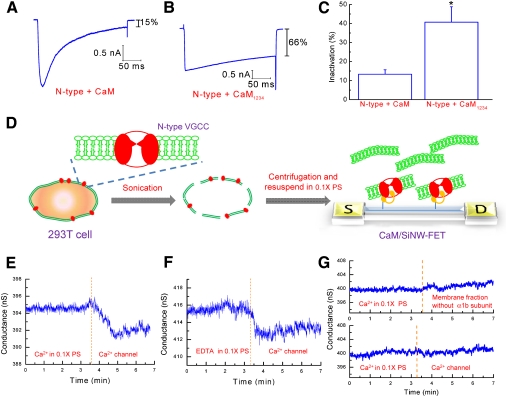Fig. 4.
Detection of N-type Ca2+ channels using the CaM/SiNW-FET. (A-C) Ca2+ currents in transfected 293T cells were recorded using a whole-cell patch configuration. The cells were voltage-clamped at -70 mV and depolarized to +20 mV for 250 ms to activate N-type VGCCs. Representative current traces from cells co-expressing N-type VGCCs with (A) CaM and (B) CaM1234 (a Ca2+ binding deficient mutant) are shown. Inactivation was obtained by normalizing the average currents between the 225 and 250 ms to the peak current during depolarization. (C) The bar graph depicts the average normalized inactivation values for cells expressing the different CaM constructs. The data represent the mean ± SEM. The sample numbers for N-type + CaM and N-type + CaM1234 are seven and five, resp. The * indicates a p-value of < 0.05, as obtained by the student’s t-test. (D) Scheme for the detection of membrane fractions containing N-type VGCCs by CaM/SiNW-FET. (E-F) The electrical measurements represent the real-time detection of the binding of an N-type Ca2+ channel to the CaM/SiNW-FET in 0.1 × PS supplemented with (E) 10-4 M Ca2+ or (F) 0.5 mM EDTA. (G) Two control experiments were conducted separately. (Top graph) Sensing of the membrane fraction without the α1b subunit by the CaM/SiNW-FET in 0.1 × PS supplemented with 10-4 M Ca2+. (Bottom graph) Sensing of a Ca2+ channel with a GST/SiNW-FET in 0.1 × PS supplemented with 10-4 M Ca2+. The protein concentration for the sensing experiments was 1.7 μg/μL.

